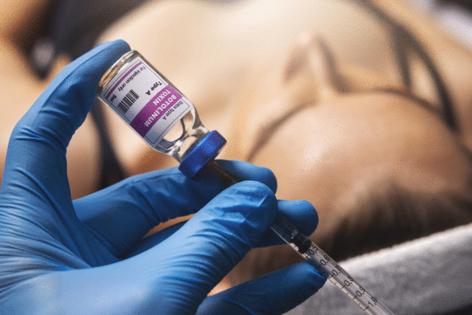Erin Lowry: Now's the right time for Gen Z to ask: Is Botox worth it?
Published in Op Eds
Rumblings of a recession always lead to a panicked analysis of consumer spending patterns.
People taking fewer trips to cut and color their hair, for example, means the beauty salon indicator is dinging — “recession hair” is already trending on TikTok. Some analyze the “beer index” to see if pricey craft IPAs are being swapped for their less hoppy mass-market counterparts. The unorthodox but historically effective “stripper index” is when exotic dancers anticipate a recession based on the decline of customers frequenting clubs.
But there could be a silver lining to the pressure to change spending habits in an economic downturn. Perhaps this moment is a solution to a worrying Gen Z beauty trend: cosmetic injectables. It’s an expensive and rapidly rising habit among a cohort of young adults who still have the beauty advantage of youth.
Between 2019 and 2022, the number of people ages 18 and 19 receiving neuromodulator injections (such as Botox) increased 75% and those getting hyaluronic acid fillers (such as Juvéderm Ultra) jumped 71%, according to a 2022 procedural statistics report from the American Society of Plastic Surgeons.
The dramatic rise within the age range leveled off by ASPS’s 2023 findings — its most recently available data — with only a 9% and 8% change for both services, respectively, from 2022 to 2023. The 20 to 29-year-old cohort, which also accounts for Gen Z, saw similar changes in both reports. The cost and subsequent maintenance of these procedures are steep. Consumers paid an average of $435 for neuromodulator injections and $715 for hyaluronic acid fillers, according to ASPS member surgeons in 2023.
How did Gen Z even get to this point?
The fact that it’s the first generation born into a social media and smartphone world certainly has something to do with it. The eldest of the cohort predates the creation of both technologies, but only by roughly a decade. Social media and smartphones both existed by the time the oldest Gen Zers entered middle school and were prolific when they were in high school.
Comparatively, as a millennial, I remember Facebook launching to the public in my senior year of high school. We uploaded silly photos with no ability to doctor the image; Photoshop was left to the professionals who heavily airbrushed the waifish-looking women in magazines. It wasn’t easy being a millennial woman above a size 0 in the aughts — the experiences of pop singer and reality star Jessica Simpson come to mind. Yet, we seemed to have had it easy in comparison to Gen Z.
Although the body positivity movement gained popularity in culture and media as the group entered their teens, it was strongly countered on social media by the algorithms, the rise of influencers and the creation of FaceTune and similar apps. The ability to doctor images moved out of the hands of editors who Photoshopped celebrities and models and into the hands of anyone with a smartphone.
Social media users were able to wipe away their perceived flaws and tweak facial features to fit beauty standards. The result was “Instagram Face,” a term coined in 2019 by New Yorker writer Jia Tolentino, who described the look as having poreless skin, high cheekbones, catlike eyes, a small nose and full lips.
Social media isn’t the only culprit of facial dysmorphia in Gen Z (and everyone else), though. Front-facing phone cameras, the rise of the selfie and even people constantly seeing themselves in little squares on Zoom and similar video meetings all contribute to a distorted sense of self.
Today, Instagram Face has left the digital world. It can be seen walking the streets of big cities and small towns, and the look can often be achieved through minimally-invasive injectables like neuromodulators and fillers.
Even if a full-blown recession doesn’t materialize in the way the media frenzy indicates, the tariffs may affect the overall cost of these cosmetic procedures. For example, the syringes and needles needed for administering injectables are currently subject to a 245% tariff when imported from China. That cost would presumably be passed on to the consumer.
One thing that younger people who love these procedures may have going for them is the rise of Buy Now, Pay Later services. These companies are a go-to for Gen Z’s non-essential purchases — from concerts to vacations — and could easily seize on the opportunity to further market their services to young people. One upstart, PRIVI, is specifically targeting the beauty injectables market by offering flexible payment plans for aesthetic treatments.
With these payment options, even a recession may not be enough to trigger anticipated financial stress to curb discretionary spending. Instead, keeping up with the procedures could be deemed essential and worth any cost — including the accumulation of debt, which is how BNPL options should be treated.
But anyone going that route should remember that taking on unnecessary debt is especially risky under Trump. The Consumer Financial Protection Bureau, under his administration, is likely to forego regulations that protect Americans, including rolling back the ruling that gave consumers the right to dispute charges and demand a refund.
If Gen Z loses the financial means to modify their faces, it may become chic and viral to embrace the inevitability of aging. With any luck, that will be more than a passing trend.
_____
This column reflects the personal views of the author and does not necessarily reflect the opinion of the editorial board or Bloomberg LP and its owners.
Erin Lowry is a Bloomberg Opinion columnist covering personal finance. She is the author of the three-part “Broke Millennial” series.
_____
©2025 Bloomberg L.P. Visit bloomberg.com/opinion. Distributed by Tribune Content Agency, LLC.




























































Comments